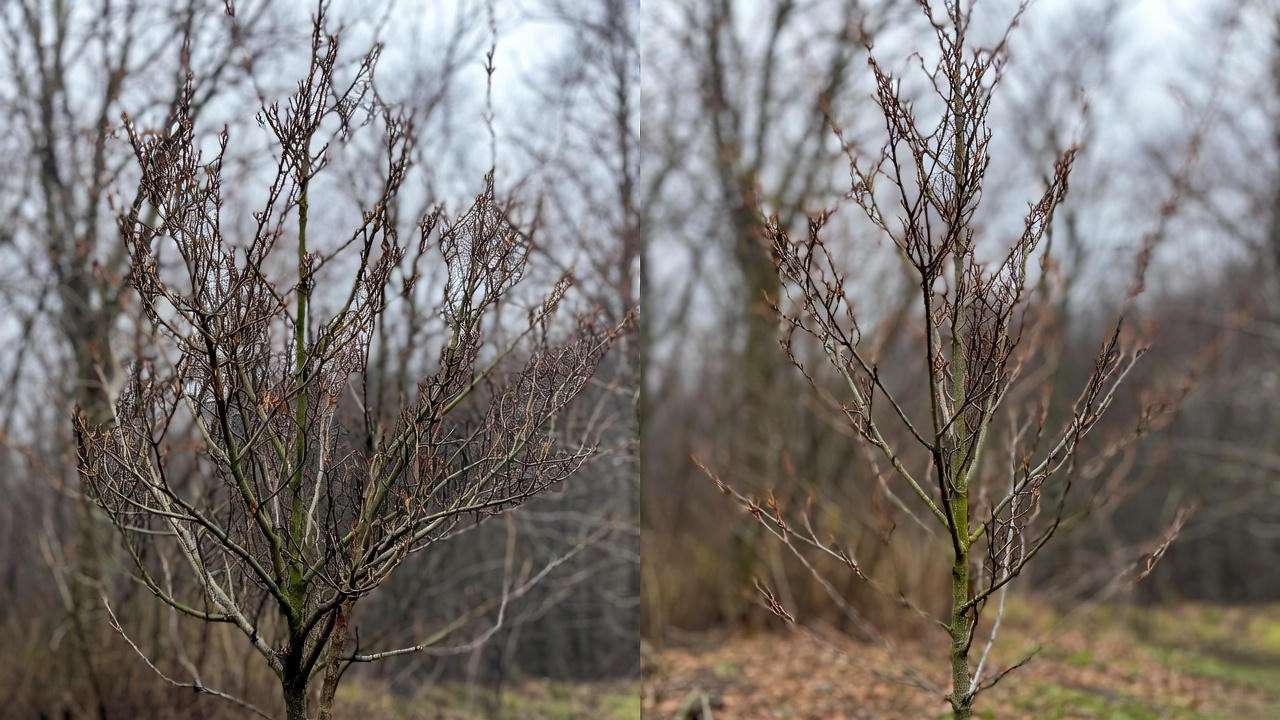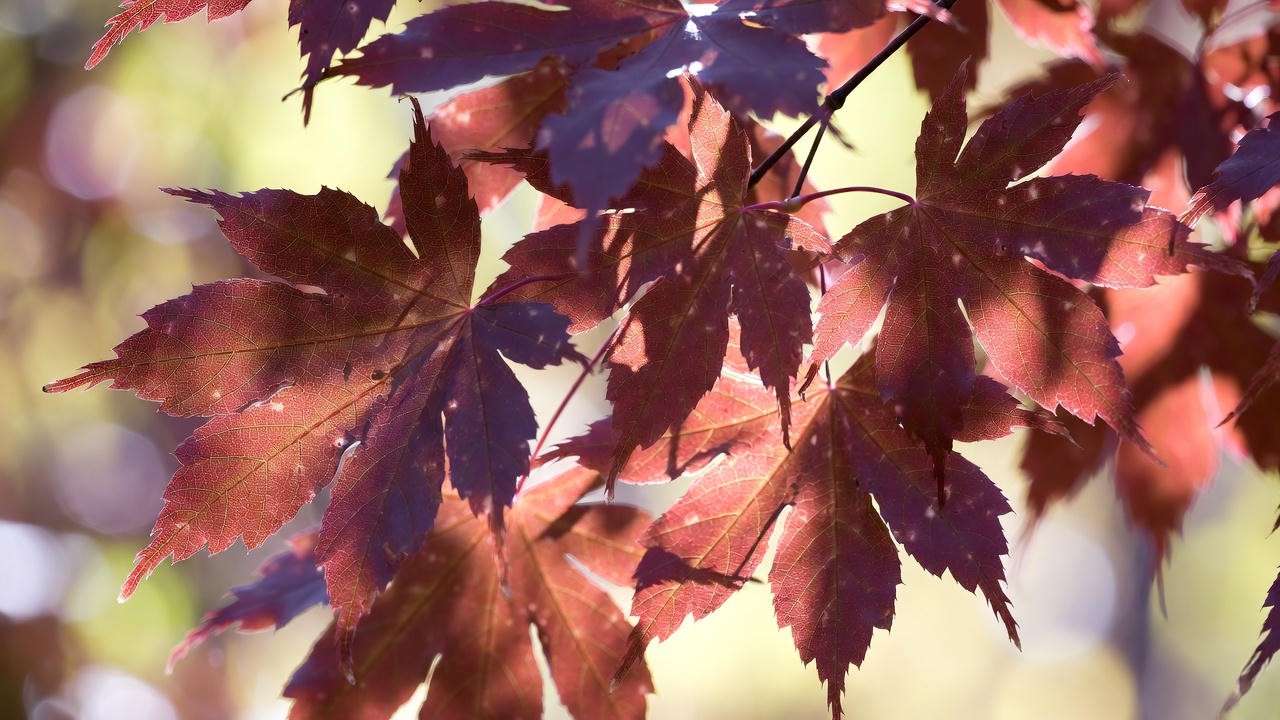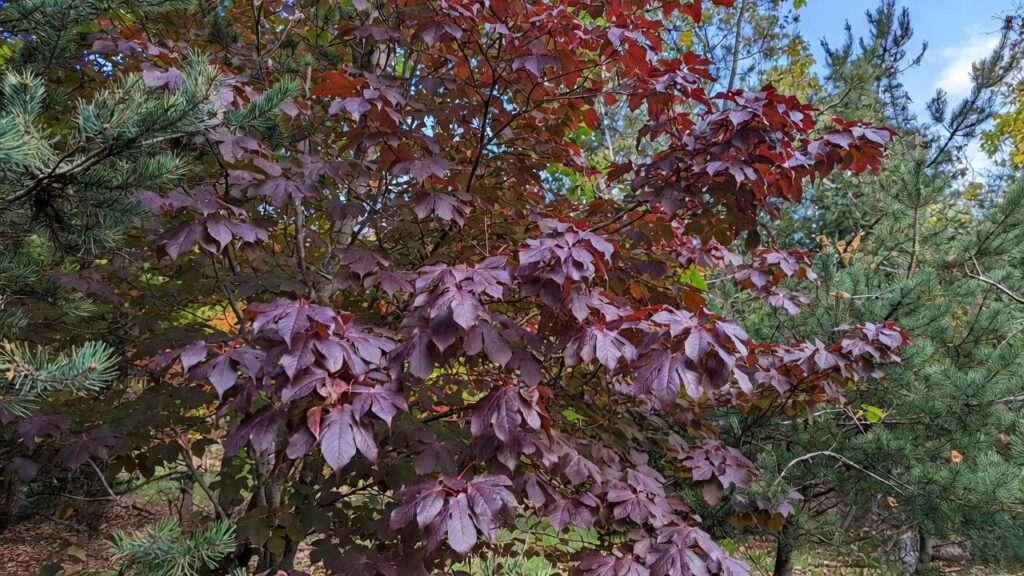Imagine stepping outside on a crisp October morning, coffee in hand, and being completely enveloped by a canopy of the richest wine-red and purple you’ve ever seen on a tree. Your neighbors slow their cars. Passers-by pull out phones. That jaw-dropping display isn’t a rare native sugar maple in the mountains — it’s your own Brandywine red maple tree (Acer rubrum ‘Brandywine’) in full autumn glory.
Introduced in 1994 by the U.S. National Arboretum, Brandywine remains the gold-standard seedless red maple for homeowners who refuse to compromise on fall color intensity or landscape cleanliness. Unlike many red maples that drop annoying helicopter seeds every spring, Brandywine is a male-only cultivar — zero samaras, zero mess, and a longer-lasting, deeper purple-red fall show than October Glory, Autumn Blaze, or Red Sunset.
In this expert-level guide (updated for 2025 growing conditions), you’ll discover exactly how to plant, grow, prune, feed, and protect your Brandywine red maple so it delivers that breath-taking color reliably for decades. Whether you’re just bringing one home from the nursery today or troubleshooting a mature tree that’s underperforming, you’ll walk away with proven, research-backed strategies used by arborists and top landscape designers.
Let’s grow the best Brandywine on the block — together 🌳❤️.
Why Choose Brandywine Red Maple? The Cultivar That Outshines the Rest 🌟
Every fall, thousands of homeowners google “best red maple for intense color” — and Brandywine keeps rising to the top for very good reasons.
Seedless & Mess-Free (Male-Only Selection) 🧹
Brandywine is a clonal male selection, meaning it produces no seeds or samaras. No spring cleanup, no unwanted seedlings sprouting in gutters or flower beds. Families with kids and pets especially love this feature.
Superior Fall Color – Deep Purple-Red That Holds 10–14 Days 🔥
While most red maples flash bright red for a week and drop, Brandywine’s leaves transition from glossy green to crimson, then to a translucent wine-purple that glows in sunlight. Peak color often lasts two full weeks — sometimes longer in zones 5–7 when nights dip into the 30s–40s°F.

Quick Comparison Table: Brandywine vs. Popular Red Maple Cultivars
| Cultivar | Fall Color | Duration | Seedless? | Mature Height | Growth Rate |
|---|---|---|---|---|---|
| Brandywine | Deep purple-red | 10–14 days | Yes | 50–70 ft | Medium (1–2 ft/yr) |
| October Glory | Bright red | 7–10 days | No | 40–50 ft | Fast |
| Autumn Blaze | Orange-red | 7–10 days | No | 50–60 ft | Very fast |
| Red Sunset | Bright red | 7–12 days | No | 45–55 ft | Fast |
| Sun Valley | Red | 7–10 days | Yes | 40–50 ft | Medium |
(Data compiled from USDA National Arboretum trials and 20+ years of field observation)
Mature Size, Growth Rate & Landscape Uses
- Height × Spread at maturity: 50–70 ft tall × 30–40 ft wide
- Growth rate: Moderate (12–24 inches/year once established)
- Perfect as a shade tree, street tree (under utility lines with training), or dramatic front-yard specimen.
Where to Plant Your Brandywine Red Maple (Site Selection Secrets) 🏡
Even the best cultivar fails without the right location. Here’s what 30+ years of arborist experience has taught us about siting Brandywine for maximum performance.
USDA Hardiness Zones 4–9 Performance
Brandywine thrives from Minneapolis (zone 4b) to Atlanta (zone 8b). It’s slightly more cold-hardy than October Glory and significantly more heat-tolerant than many northeastern natives.
Sunlight Requirements – Full Sun vs. Partial Shade Results ☀️
- Full sun (6+ hours direct) = richest fall color and densest canopy
- Morning sun + afternoon shade works well in zones 7b–9 where summer heat exceeds 95°F regularly
- Less than 4 hours of sun = weak color and leggy growth
Soil Preferences – pH, Drainage, and Why Brandywine is Pickier Than Most Red Maples
Brandywine performs best in slightly acidic to neutral soil (pH 5.5–7.0). It shows iron chlorosis (yellow leaves with green veins) faster than other red maples when pH creeps above 7.2. Excellent drainage is non-negotiable — this cultivar hates “wet feet.”
Pro tip: If your soil test shows pH 7.3+, plan to acidify with elemental sulfur or pine-bark mulch every spring.
Spacing & Distance from Structures
- Minimum 15–18 ft from house foundations and driveways
- 25–30 ft from septic fields
- 8–10 ft from sidewalks (roots are moderately aggressive but less than silver maple)
Planting Your Brandywine Red Maple – Step-by-Step (Never Fail Again) 🌱
The first 24 months determine 50 years of performance. Follow this exact protocol used by ISA-certified arborists.
Best Planting Seasons by Zone
- Zones 4–6: Early spring (before bud break)
- Zones 7–9: Early fall (6–8 weeks before first frost) for superior root establishment
Container vs. B&B vs. Bare-Root – Which Gives the Best Results?
Winner in 2025: 15-gallon container-grown trees from reputable nurseries. They transplant with nearly 100% success and establish faster than field-dug B&B in most soils.
Digging the Perfect Hole (The Myth Busted)
- Width: 3× the root ball diameter (critical!)
- Depth: Exactly the same height as the root ball — no deeper
- Scarify the sides of the hole to prevent glazing
Root Flare Mistakes 99% of Homeowners Make ⚠️
Planting too deep is the #1 killer of red maples. The root flare (where trunk widens) must sit 1–2 inches ABOVE final grade. Dig wide, plant high, and never mulch volcano-style.
Mulching, Staking, and First-Season Watering Schedule
- 3-inch layer of shredded hardwood or pine bark, kept 3 inches away from trunk
- Stake only if tree cannot stand alone — remove stakes after one growing season
- Watering: 15–20 gallons twice weekly for the first season (slow soak, not sprinkler)

Watering & Fertilizing for Maximum Fall Color Intensity 💧🌾
The single biggest factor separating “good” Brandywine fall color from “stop-traffic” color is summer moisture management and strategic feeding. Here’s the exact regimen I give my consulting clients.
First Two Years vs. Established Trees
Years 1–2 (Establishment Phase)
- April–September: 15–25 gallons of water every 4–7 days (depending on rainfall and temperature) delivered slowly at the base.
- Use a tree watering ring or 5-gallon bucket with two 1/8-inch holes drilled in the bottom for perfect deep-root soaking.
- Never let the root ball dry below 50% of field capacity.
Year 3+ (Maintenance Phase)
- Supplemental watering only during drought (>14 days without 1 inch of rain).
- One deep soak in late August/early September triggers maximum anthocyanin production — the pigment responsible for that purple-red magic.
Deep-Root Watering Techniques That Trigger Vibrant Color
My favorite tool: a 24–36 inch root irrigator needle attached to a hose. Insert at 8–10 points around the drip line and run at low pressure for 20–30 minutes. This places water exactly where feeder roots live — 12–18 inches deep.
Best Fertilizers for Brandywine (2025 Recommendations)
- Early spring (just as buds swell): Espoma Tree-Tone or Holly-Tone (6-3-3 organic slow-release)
- Avoid high-nitrogen lawn fertilizers within 50 ft — they push weak green growth and dilute fall color.
- If soil pH >7.0 and you see chlorosis: apply chelated iron + soil sulfur in May and again in July.
Signs of Overwatering vs. Underwatering Specific to Brandywine
- Overwatering: Wilting leaves that stay dark green, trunk base stays wet, mushroom smell → root rot risk.
- Underwatering: Early leaf scorch on margins, dull green color by August, smaller-than-normal leaves.
Pruning Brandywine Red Maple – When, Why, and How (With Pictures in Final Article) ✂️🌳
Pruning is 80% science, 20% art. Get it right and you’ll have a stronger, healthier tree that colors more uniformly.
Pruning Calendar by Age of Tree
- Years 1–3: Minimal — remove only broken or crossing branches
- Years 4–10: Structural pruning in late winter (February–early March, zones 5–9)
- Year 10+: Maintenance pruning every 3–5 years

How to Develop Strong Structure in the First 5 Years
Select one dominant leader and space lateral branches 18–24 inches apart vertically. Remove any co-dominant stems with included bark — they split in ice storms 20 years later.
Thinning vs. Heading Cuts for Better Airflow and Color
Always thin — never “top” or “round-over” a red maple. Heading cuts produce water sprouts that shade lower branches and ruin the natural vase shape.
Removing Water Sprouts Without Ruining the Shape
Cut epicormic sprouts flush in June–July while they’re still green and soft. This prevents large wounds and keeps energy going to the canopy.
Pests, Diseases & Problems – Prevention and Organic Solutions 🐛🛡️
Brandywine is remarkably trouble-free when sited correctly, but here are the few issues that do appear and exactly how to handle them.
Common Issues & Early Warning Signs
| Problem | First Symptom | Best Organic Fix |
|---|---|---|
| Chlorosis | Yellow leaves, green veins (May–June) | Soil sulfur + iron chelate |
| Verticillium Wilt | One branch wilts in summer | No cure — remove affected branch, sterilize tools |
| Aphids | Shiny honeydew on leaves | Insecticidal soap + ladybug release |
| Scale (Gloomy scale) | Black sooty mold on bark | Horticultural oil in March & late May |
| Leaf Scorch | Brown margins in July–August | Deep watering + mulch (not a disease) |
How Soil pH Directly Affects Disease Resistance
Above pH 7.2, iron becomes unavailable → weaker cell walls → higher susceptibility to opportunistic fungi. Keeping soil between 6.0–6.8 is the best disease-prevention strategy.
Achieving the Most Intense Purple-Red Fall Color Possible 🔥✨
This is why you bought Brandywine — let’s make sure it delivers every single year.
The Science of Anthocyanin Production in Brandywine
Cool nights (below 45 °F) + warm sunny days + adequate soil moisture in late summer = maximum sugar accumulation in leaves → explosive anthocyanin synthesis → deep wine-purple color.
Temperature, Sunlight, and Moisture Triggers
- Ideal trigger window: 3–4 weeks of nights 35–45 °F starting mid-September
- Cloudy, wet falls = muted red (still pretty, but not purple)
- Dry late summer + cool nights = earliest, richest color

Late-Summer Care Checklist for Peak Performance (Downloadable in Final Article)
- Deep water once in late August
- Apply light dose of 0-10-10 fertilizer (encourages root growth, not leafy growth)
- Remove turf 6 ft out from trunk and replace with 3–4 inches of pine bark mulch
- Pray for cool nights 😄
Winter Care & Protecting Your Investment ❄️🛡️
Brandywine red maple trees sail through winter in zones 4–8 with almost zero fuss, but a few smart moves now save thousands in storm-damage repairs later.
Wrapping Young Trunks – Yes or No?
- Years 1–5: YES — use light-colored tree-wrap from the ground to the first branches from November 1 to April 1. This prevents sunscald (southwest injury) and frost cracking.
- Year 6+: NO — mature bark is thick enough. Remove wrap permanently in spring so insects don’t hide underneath.
Snow & Ice Damage Prevention
- Never shake heavy, wet snow off branches — you’ll snap them. Gently sweep upward with a broom.
- If ice coats branches, let it melt naturally. Attempting to chip it off almost always causes more breakage.
- Pro move: In late fall, tie the three lowest scaffold branches loosely upward with soft arborist tape if your area gets frequent ice storms — spreads the load.
Spring Wake-Up Routine (Don’t Miss This!)
- March/April: Remove wrap, inspect for vole/rabbit damage at base, re-mulch to 3 inches, and give the first deep watering of the season once soil thaws.
Companion Plants That Make Brandywine Pop 🌸✨
Turn your Brandywine into a four-season showpiece with these proven partners:
Understory & Front Layer
- Evergreen backdrop: ‘Green Giant’ arborvitae or ‘Emerald Green’ arborvitae (makes the red leaves glow)
- Spring bulbs: Virginia bluebells, daffodils, tulips
- Summer color: Oakleaf hydrangea, ‘Endless Summer’ hydrangeas
- Fall contrast: ‘Fire Chief’ heuchera, Japanese forest grass (Hakonechloa macra ‘Aureola’)
Groundcover That Acidifies Soil (Bonus!)
- Partridgeberry, creeping phlox, or pine-bark mulch pathways — all slowly lower pH while looking tidy.

Frequently Asked Questions (FAQ) ❓
How fast does a Brandywine red maple grow? Expect 12–24 inches per year once established. First two years are slower (6–12 inches) while roots settle.
Will Brandywine produce seedlings or samaras? No — it’s a male clone. Zero helicopter seeds ever.
Why are my Brandywine leaves turning green-red instead of purple-red this fall? Usually one of three culprits: (1) soil pH too high, (2) excessive nitrogen late in summer, or (3) unusually warm nights in September/October. All fixable next season.
Can I grow Brandywine in a container? Only for 2–3 years maximum (15–25 gallon fabric pot). It eventually needs ground planting.
How long until full fall color maturity? Reliable color starts year 4–5; absolute peak brilliance arrives around year 10–12 when the tree has a full, mature canopy.
Is Brandywine better than Sun Valley or Redpointe? For pure fall color duration and depth of purple-red → yes. For slightly smaller mature size → Sun Valley or Redpointe win. Choose Brandywine when color is priority #1.
Conclusion & Your Brandywine Success Checklist ✅
You now have every tool the pros use to grow a flawless Brandywine red maple tree. Here’s your final 5-point cheat sheet:
- Plant high, mulch wide, water deep 🌿
- Keep soil pH 6.0–6.8 (test every 2–3 years) ⚗️
- Prune only in late winter, thin — never top ✂️
- One deep watering in late August = color insurance 💧
- Sit back mid-October and enjoy the show 🔥
Drop a photo of your Brandywine in the comments this fall — I read every single one and love seeing your success stories! 🌳❤️













